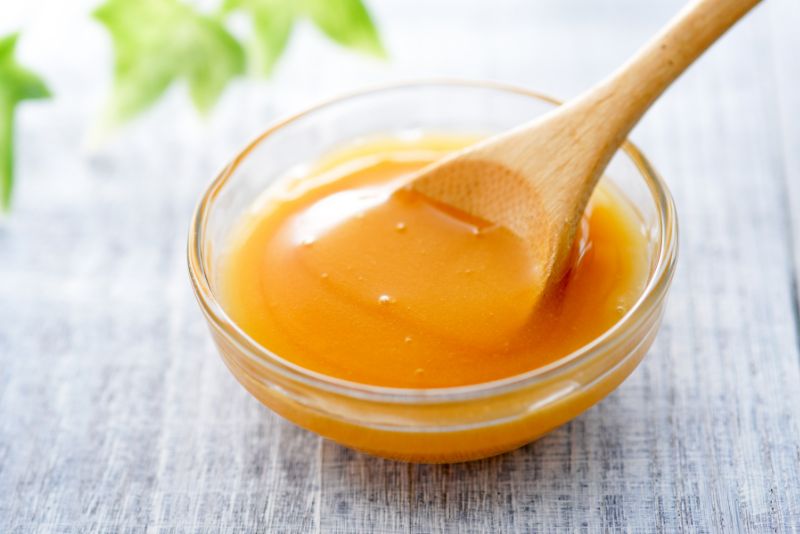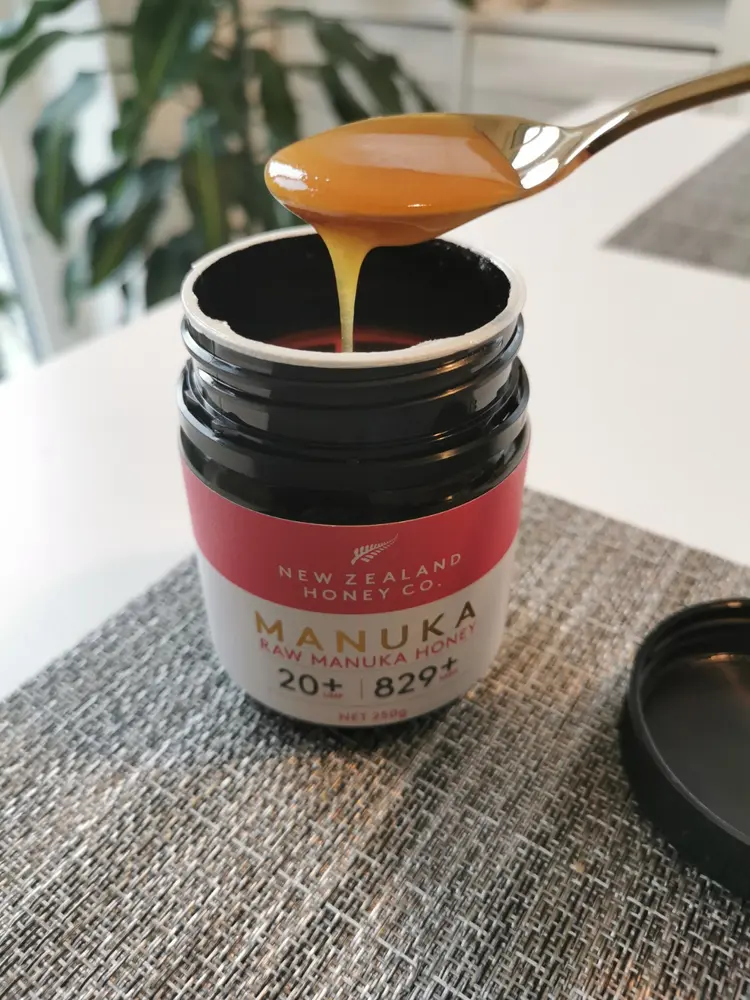Taking too much manuka honey per day may lead to certain repercussions. Instead, it is best to moderate and get the perfect amount. When the honey is added to your diet, you should take a maximum dose of two teaspoons or 15 grams per day.
The exact dose you should take per day depends on what you want to achieve and the grade of manuka honey you have. Use the information below to find the perfect dose.
Table of Contents
- Is It Possible To Take Too Much?
- What Is The Recommended Dosage?
- Can Eating Too Much Honey Be Bad?
- The Grade Matters
- Is Any Amount Of Raw Honey Safe?
- Can Diabetics Use Manuka Honey?
- How Much Manuka Honey For Acne?
- How Long Can Manuka Honey Remain On Your Skin?
- Applying Manuka Honey To An Open Wound
- How Much Manuka Honey Per Day For Skin Moisturizer
- Manuka Honey For Immunity Maintenance
- Frequently Asked Questions
Is It Possible To Take Too Much?
Manuka honey tends to be very safe, but there are still risks involved. Therefore, it is best to be cautious and avoid overdoing it. Otherwise, you may run into issues.
Nevertheless, the honey is relatively safe so the risks are minimal. One thing to remember is that honey has a high content of sugar. Therefore, diabetics shouldn’t consume large amounts.
Doing so could cause your blood sugar levels to spike. In many cases, it doesn’t take a lot to achieve the intended goals.
If you have a bottle of high-grade manuka honey, it is likely best to reduce the dose.
What Is The Recommended Dosage?

Again, there is no perfect dosage of manuka honey. Instead, it depends on several circumstances, including the grade and what you’re trying to achieve. You should also consider your overall health.
On average, the recommended dose is around 21 grams of manuka honey per day. This amounts to a tablespoon each day. Alternatively, you can consume three teaspoons per day.
If you eat three meals a day, you can add some honey to each recipe.
Can Eating Too Much Honey Be Bad?
Although manuka honey is generally safe, eating too much honey could cause problems. In particular, eating too much honey is problematic for diabetics. Furthermore, it is pertinent to combine honey with a healthy, balanced diet.
The primary problem with honey is its high sugar content. Since it contains so much sugar, it can cause blood sugar levels to skyrocket.
If you’re going to use manuka honey, you need to do so moderately. At some level, too much is going to cause more problems than benefits.
Instead, honey should be consumed in small amounts throughout the day. A spoonful per day should be enough to take advantage of manuka honey’s benefits.
However, there might be times when it is best to add more. If you’re trying to deal with a sore throat or a sore stomach, you can add another spoonful. Just make sure that you don’t consume too much in one day.
The Grade Matters
When it comes to manuka honey, consumers will find that there are various grades. Each is different in terms of content and strength.
If you have a high-grade manuka honey, using too much could be problematic. It is easier to use too much because the honey is so potent.
Therefore, you have to know what you’re doing and what you’re working with. Low-grade manuka honey can be used more frequently.
High-grade manuka honey should be used infrequently. If you want to use this honey multiple times every day, it’d be wise to choose a low-grade product.
Refer to the UMF rating of the product to know whether you’re getting a high-grade or low-grade concentration.
Also read: What Is MGO In Manuka Honey?
Is Any Amount Of Raw Honey Safe?
In some cases, raw food products are not safe. Instead, they tend to be safer when they’re processed. The good news is that this normally isn’t a problem with raw honey.
Processing it this way ensures that the raw honey is able to preserve its natural properties, including its antioxidants and nutrients.
If it is processed, the procedure could remove many of those essential nutrients and antioxidants. Therefore, it is generally best to consume raw honey since it has more beneficial nutrients and antioxidants.
Again, just make sure that you’re not taking too much. One teaspoon per day should be enough to reap the rewards.
Can Diabetics Use Manuka Honey?
Some people wonder whether diabetics can safely use manuka honey. The truth is that these people can likely use these products without problems, but it is essential to moderate.
The same can be said about conventional honey too. As mentioned previously, honey contains a lot of sugar which can cause blood sugar levels to increase.
If a diabetic eats too much honey, they’re going to put themselves at risk. Diabetics can likely use manuka honey when they do so moderately.
If you’re diabetic, you shouldn’t use manuka honey regularly. Doing so could trigger problems. Instead, you can use it every so often.
Another thing to remember is that diabetics can still use manuka honey for topical purposes. If you want to heal a cut or burn, you can use manuka honey.
It won’t impact your blood sugar levels when applied to your skin.
How Much Manuka Honey For Acne?
If you’re going to use manuka honey, you need to make sure that you’re using the right amount. Even if you’re applying it to your skin, you shouldn’t overdo it.
On the other hand, using too little will not provide satisfactory results. When treating acne, you should apply a pea-sized amount to your face. Be sure to rub it thoroughly.
If you want to use more, it would be a good idea to dilute the honey with water. A few drops should do the trick.
Manuka honey can also be mixed with other products. You can add it to your favorite lotion before using it to treat your acne.
How Long Can Manuka Honey Remain On Your Skin?
Ultimately, manuka honey is safe although you shouldn’t leave it on your skin for too long. Leaving it on your skin for too long could clog the pores or cause other issues.
With this in mind, you should try to remove the honey from your skin after 15 minutes. If you’re going to use a mask, you can leave it on your skin for a little longer.
When using a manuka honey mask, the substance can remain on your skin for up to 30 minutes. Be sure to clean your face thoroughly.
Wash your face twice to be positive that all honey has been removed.
Applying Manuka Honey To An Open Wound
You can safely apply manuka honey to an open wound. It works well as a wound dressing because it will ensure that the environment remains moist.
Furthermore, manuka honey is an effective autolytic debriding agent. Some studies have found that manuka honey can speed up the healing process.
If you’re going to use manuka honey to heal an open wound, start by applying a small amount to your hand.
Manuka honey can be applied to open wounds throughout the day without issues. However, you don’t want to use too much honey because it may transfer to your clothes and furniture.
How Much Manuka Honey Per Day For Skin Moisturizer

Manuka honey has properties that not only aid in faster healing but also soften rough, dry skin. The best Manuka honey concoction for dry, scaly skin is a homemade face mask.
Combine a dash of one tablespoon of Manuka honey with ¾ teaspoon of turmeric, ¼ teaspoon of fresh lemon juice, and a dash of apple cider vinegar.
Mix thoroughly until the correct consistency is achieved before applying a moderate layer to the skin.
Leave the Manuka honey mask in place for about 20 minutes before rinsing. Follow up with a quality moisturizer to maximize the effectiveness of the honey mask.
It is recommended to utilize the treatment bi-weekly or until improvements are noted. Reduce the treatment to weekly only when the skin looks softer and more youthful.
Manuka Honey For Immunity Maintenance
An underperforming immune system is difficult to live people. The culprit is generally a birth defect or long-timer use of steroids and other medications known to suppress the immune system.
When the immune system underperforms, it increases the risk of ear, respiratory, skin, and brain inflammation and infections. Low immunity also causes blood disorders like anemia and digestive problems.
Adults should ingest one tablespoon of Manuka honey daily to boost their immunity. Children over the age of 18 months should not take more than ½ tablespoon daily.
If no improvement is noted after 30 days, speak with your primary care physician or the child’s pediatrician.
Frequently Asked Questions
What Is The Recommended Daily Intake Of Manuka Honey?
A Healthline report reveals the daily recommended intake for Manuka honey is two tablespoons. The medical community advises against a higher-than-recommended intake because it is not necessary.
The daily intake can depend on the targeted weight loss, health condition, or immune support. Healthline recommends no more than one tablespoon for immunity maintenance.
Who Should Not Ingest Manuka Honey?
Children under 18 months of age should not consume Manuka honey. Infants as young as one year old have been diagnosed with Clostridium botulinum after ingesting Manuka honey.
Diabetics can ingest Manuka honey but only in moderate amounts.
What Is The Recommended Amount Of Manuka Honey For A Burn?
The amount of Manuka honey utilized in wound care will depend on whether or not there is drainage and the type of wound. If no drainage is present, ¼ to ½ tablespoon is appropriate for treating minor lacerations.
When drainage is present, increase the amount to ¾ to 1 tablespoon. Manuka honey has been proven to reduce bruising related to an injury. The dressing may need to be changed more often if a lot of drainage is noted. Otherwise, twice a day should suffice.

